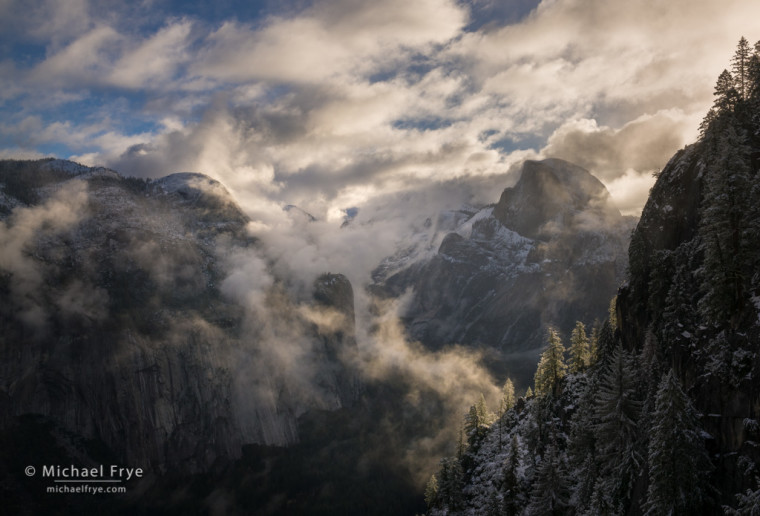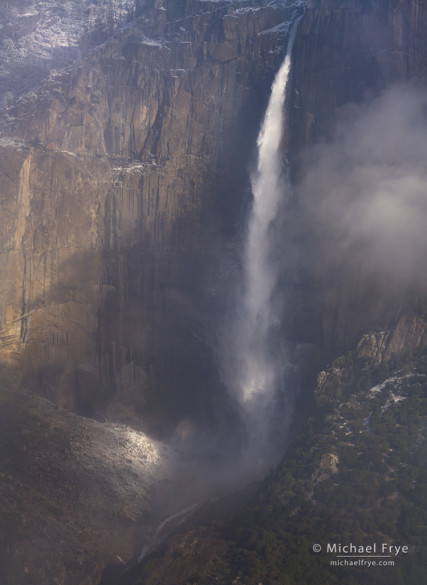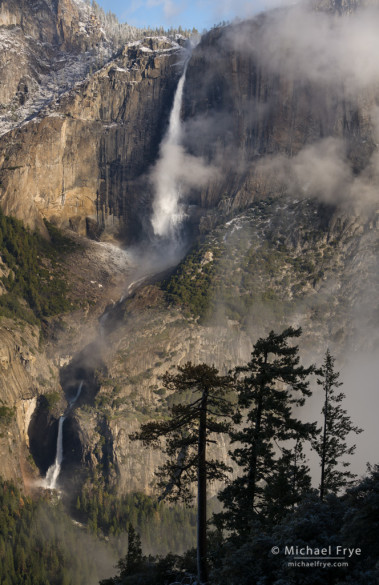A small storm rolled through Monday night. The showers tapered off during the wee hours Tuesday morning, and I rose early, hoping to once again photograph a clearing storm in Yosemite Valley.
The moon was nearly full, and I actually got to the valley early enough to capture some images of the clearing storm by the light of the setting moon. Then some clouds moved in. I looked at the radar images on my phone, and saw a band of showers approaching. It looked like the showers would reach me around sunrise, and pass through pretty quickly. Hmm. I might have just enough time to hike up the Four-Mile Trail to a spot with a view of Half Dome that I’d been wanting to try.
It would be a gamble. Staying near the roads on the valley floor would give me more flexibility; I could wait to see what happened with the weather, and within five or ten minutes be at one of my favorite, familiar locations. But on this morning I wanted to try something different, so I decided to take a chance and go for it.
I hoofed it up the trail as fast as my legs and lungs would allow. The anticipated showers never materialized, and the skies started clearing earlier than I expected, which meant I might reach my spot too late to catch the best light. I thought about turning around, but decided to roll the dice and see what happened. My rationalization was that the trail has good views toward Cathedral Rocks and El Capitan to the west, and Yosemite Falls across the valley, so if the skies cleared before I reached the view of Half Dome there were other possibilities.
I did stop briefly to photograph the view down the valley to the west, but then kept going up. The sun broke through and lit the cliffs to the west of Yosemite Falls, but the light wasn’t compelling enough to make me want to stop. Upward!
When I finally reached the view of Half Dome at about eight o’clock I found a gorgeous scene, with backlit mist, clouds, and trees coated with a dusting of snow. I was glad I had persevered. The light and mist show continued for about half an hour, but my favorite image is the one at the top of this post, made just after I arrived. Apparently I got there just in time.
When the light became less interesting for that view I moved down the trail to photograph Yosemite Falls. The sun had reached the waterfall by then, and mist kept forming and rising, hiding and revealing parts of the waterfall. I’ve included a couple of those images below.
They say that familiarity breeds contempt, but that hasn’t been my experience with Yosemite Valley. I’ve lived in and near the valley for over 30 years, and haven’t grown tired of photographing it. If anything, my familiarity with the valley has made me look more deeply, and forced me to become more creative in my interpretations. I know there are many beautiful, intimate compositions that I haven’t discovered yet. Changing weather, seasons, and conditions are always creating new possibilities for both large and small scenes. Recent advances in camera technology have allowed me to capture images of clearing storms and other interesting lighting events after dark.
And there are many wonderful views of the valley that I haven’t photographed before – or at least I haven’t photographed those views in prime conditions, like during a clearing storm. It’s hard to do that, because reaching those spots requires hiking, which takes time and effort. As this little story shows, it’s a gamble. I could spend a lot of energy climbing up a thousand feet or more above the valley, only to realize that I would have been better off going to Tunnel View. That’s happened to me more than once.
But it’s not all about the results – about “getting the shot.” For me, it’s fun to be up and away from the crowds, seeing the valley from new perspectives, with interesting and unusual weather conditions, even if I don’t come home with any outstanding photographs. I’ve been skunked before, many times; that’s a normal part of landscape photography. For me – and, I know, for many other photographers – the effort to capture an image is partly just an excuse to get out there.
But photography is also about communication, so if the light and weather cooperate, and I can share a photograph that conveys a tiny bit of the beauty of these out-of-the-way places, that’s even more satisfying. I came down the trail on Tuesday tired, but happy. It was such a wonderful morning, an experience I’ll remember for a long time.
— Michael Frye
P.S. This should go without saying, but you shouldn’t attempt to climb up out of the valley under inclement weather unless you’re in good physical condition and have a lot of experience hiking in the mountains. And that goes double (or triple) if you’re hiking off-trail. There was very little snow below 6,000 feet on Tuesday, but normally in winter you should expect to encounter snow and ice on the trails. Rockfalls and avalanches are more common after storms, so you should be able to recognize rockfall and avalanche hazard zones and avoid them. And of course you should obey all the rules, including closures. (The Four-Mile Trail, for example, is typically closed just below Union Point in winter, but sometimes it’s closed below that.) And hiking alone is not recommended. I’m a very experienced hiker and mountaineer, and when Claudia doesn’t come with me on these ventures I text her regularly to let her know where I am. (AT&T cell coverage is surprisingly good on some of the trails around Yosemite Valley.)
Related Posts: A Harebrained Idea; Misty Morning; Yosemite Falls by Moonlight
Did you like this article? Click here to subscribe to this blog and get every new post delivered right to your inbox!
Michael Frye is a professional photographer specializing in landscapes and nature. He is the author or principal photographer of The Photographer’s Guide to Yosemite, Yosemite Meditations, Yosemite Meditations for Women, Yosemite Meditations for Adventurers, and Digital Landscape Photography: In the Footsteps of Ansel Adams and the Great Masters. He has also written three eBooks: Light & Land: Landscapes in the Digital Darkroom, Exposure for Outdoor Photography, and Landscapes in Lightroom: The Essential Step-by-Step Guide. Michael has written numerous magazine articles on the art and technique of photography, and his images have been published in over thirty countries around the world. Michael has lived either in or near Yosemite National Park since 1983, currently residing just outside the park in Mariposa, California.












Michael, I love receiving your emails with your beautiful photographs, especially those in Yosemite. I was lucky enough to visit Yosemite from England a couple of years ago and it now has a special place in my heart.
I enjoy hiking though, only had 3 days in Yosemite. This hike looks as though it has beautiful views. It is always worth putting the effort in to get the views like these. Your photographs are stunning and make me smile. Due to the time difference I often wake up to them, a great way to start the day! Thank you for sharing your photos and tips.
Thanks Jane – I’m glad you’re enjoying the blog. The Four-Mile trail does indeed have beautiful views, especially during a clearing storm!
Michael,
Four-mile is a fantastic trail for such views. Your photographs provide proof. All phenomenal! Each are unique and worth the effort.
Thanks!
Cheers,
Alyn
Indeed it is Alyn – thanks!
Yes, Michael, the artist must suffer for his art – by huffing and puffing on the difficult trails and braving and outwitting the elements as you do so frequently.
Again, a wonderful backstory and splendid photos!
Thanks so much Chuck!
Love seeing these familiar sights but from different points of view! The photos are dreamy. Like you, I never tire of Yosemite NP regardless of how many times I have been there. It’s the thick crowds of tourists and multiple vehicles that ruin so much of the park experience, in my opinion. I enjoy the little out of the way places you mention for peace and seclusion.
You must be in great shape to tackle the Four-Mile Trail! It is incredibly difficult, especially when carrying all your photography gear. Heck, I only did the trail once and that was from the top down! Thank goodness for Glacier Point Road, when it’s open.
Thanks for keeping it all fresh with your perspectives.
Thanks Ann! Not in that great shape, but I was motivated. 🙂 I didn’t have to hike the whole trail to get to this view (it’s closed just below Union Point in winter anyway, so there’s only so far you can go).
Gorgeous views. I have never hiked that trail. We are usually with my now 92 year old father-in-law when we are in the park. He does make it up past the bridge to Vernal to a place we cal Bob’s Rock, so he is pretty good for many trails. Amazing.
I was wondering how far up the trail you need to hike to get to some of these views?
Thanks Aram. It depends; the view of Half Dome is quite far up, but you can get good views of Yosemite Falls starting at around the 4,600-foot elevation, so about 600 feet up. However I think the views of the falls are better higher up, from about 5,200 feet to 6,000 feet.
Thanks, Michael. I will possibly scout it out for him when we are there next month.
Absolutely breathtaking! Such commitment, what a reward for the effort. I assume you used the A7R2 for this trip up? I am curious to what lens you are mating up with the Sony that compliments the 42mp sensor. I have the A7R and cannot put anything on it over 100mm or I get blurred pics from shutter shock issue. We are planning a trip there later this summer and looks like a 70-200 would benefit me better than wide.
Kathryn
Thanks Kathryn! Yes, I used the A7rII. I use mostly a Canon 70-200 f/4, an old Nikon 50mm f/1.8, and a Rokinon 24mm f/1.4. I used the A7R as my primary camera for almost two years, so I’m quite familiar with the shutter shock issue. The best cure is to get the vertical battery grip with an L-bracket, as that almost completely eliminates the issue. I show an example in my review of the A7r:
https://www.michaelfrye.com/2014/04/18/sony-a7r/
I still tried to avoid shutter speeds between 1/30th and 1/125th with that camera, even with the battery grip, because I could see a slight loss of sharpness compared to other shutter speeds, but I made many very sharp images with the A7r with focal lengths longer than 100mm.
>We are planning a trip there later this summer and looks like a 70-200 would benefit me better than wide.
I don’t know what focal lengths you have now, but you’ll want both wide-angle and telephoto lenses for Yosemite.
I really like these photos and particularly enjoy seeing the valley from different views. There are so many Tunnel View and Glacier Point (in summer) shots – I think they’re what Galen Rowell might have called “mature” at this point. There are so many possibilities in the Valley alone, not to mention the high country. I think this is great encouragement for people to “get out there”. And thank you for sharing your work and knowledge, it’s always enlightening. Your description of the zone system in Digital Landscape Photography was especially influential for me.
Thanks Josh! I’m glad you like the photos, and the book. I’ve seen creative photographers do new and interesting things with seemingly over-photographed subjects before, so I would never say that there’s nothing new to do at Tunnel View or Glacier Point. But your point is well taken.
I love the views you grabbed of Yosemite Falls. It’s always nice to see different perspectives than the “regular” ones.
Personally, I would rather be away from the crowds and get skunked with photos than have to go elbow-to-elbow for a shot. That’s my perspective, though, and I know everyone is different.
I think that there are many places that never get old, and Yosemite (both the Valley and the high country) is one place that I will never tire of. I don’t get there nearly as often as I’d like, but I love every minute that I spend there.
~Peter
Thanks Peter! Going elbow-to-elbow hasn’t been a common experience for me in Yosemite Valley, except perhaps at Tunnel View and Gates of the Valley at certain times. At other times, fortunately, even those spots are empty.
Amazing images, you perfectly clicked the grandeur of Yosemite in your shots. I just love these shots. I am an aspiring photographer who is just starting on this art and your images inspire me to keep learning.
I am visiting Yosemite this weekend and plan to hike the 4-mile on one of those days. The weather forecast so far is clear and sunrise time should be around 05:00 AM. I wonder if you can suggest – what will be the best time to start hiking in morning so as to get best light to photograph the reverse tunnel view, Yosemite falls and half dome?
Another suggestion I would like to have is whether it’s feasible to take a tripod along this hike for trying long exposure. I mean, is there really a room to setup a tripod one this trail?
Thanks for your suggestions and once again kudos for such shots.
Thanks Akash – I appreciate the kind words. Sunrise will be around 5:36 a.m. this weekend. I’ve never been up the Four-Mile Trail this time of year, but Yosemite Falls doesn’t get any sunlight until about 10 a.m. in June. Half Dome would be backlit in the morning, which might be okay with some clouds or mist, but I don’t think it would work too well on a clear morning. By “reverse Tunnel View” I assume you mean looking west down the valley; Cathedral Rocks would get hit by the sun pretty early, maybe half an hour after sunrise. There’s plenty of room to set up a tripod on the trail. Good luck!
Thanks for your inputs, Michael. This is really valuable information and will help me to plan trip better.